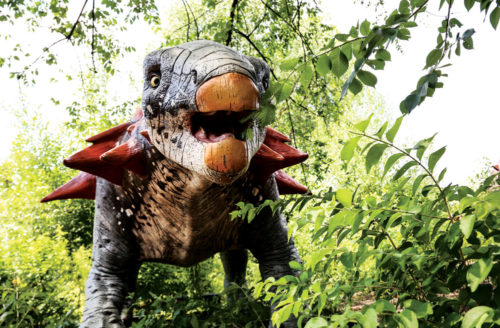
Lifesize dinosaurs move and make sounds
Twenty-one life-sized dinosaurs, most of which move and make sounds, will be residing at the Denver Zoo until October 31. The easiest way to find them is by using the Denver Zoo mobile app—and with a click visitors can also learn more about them.
Many of the dinosaurs are located near today’s zoo animals that share some common characteristics such as appearance, hunting habits, type of diet, or parenting behavior. Visitors are encouraged to looks for similarities and differences with today’s animals. Trampleton the T. rex can be compared to the spotted hyena in that the adaptations of the jaws and teeth are similar in power and structure. Both animals are scavengers and agile predators. “Though a hyena would be a snack for a Tyrannasaurus rex, we hope our guests will think about those kinds of connections between the dinosaurs and our animals at the zoo,” says Brad Parks, director of guest experience at the zoo.

This citipati the zoo has named Minerva is pictured during its installation. Minerva, like most of the dinos, is believed to be about the size she was in real life.

Though Trampleton the T. rex would have been the size of a juvenile in real life, he makes the workers look like they would be just a bite of his dinner. Note the size of the installer’s shoe (the white spot below Trampleton’s belly) compared to the T. rex’s foot.
Minerva the citipati (pictured above) was installed near the cassowaries, large feathered flightless birds. Scientists believe citipati specimens discovered together with eggs were in their nests caring for the eggs when they died. Likewise, cassowaries, are protective parents. And both citipatis and cassowaries have eyes on the sides of their heads.

Ryder Wolf, 3, has a dinosaur fight with his mom by the carnotaurus.
Kids (and inner kids) who love dinosaurs will be interested to hear how Robby Gilbert, director of exhibits for The Dinosaur Company, got his job. He was a stay-at-home dad with three daughters who saw an article in the paper about The Dinosaur Company and went to see their warehouse full of dinosaurs. While there, he met the owner—and ended up talking himself into a job. He worked directly with the owner for two years learning the ropes, and now has spent the last nine years going to zoos, museums and theme parks around the world that want to have dinosaur exhibits.

The Utahraptor, a large feathered dinosaur, is located next to Bird World based on its similarities to today’s raptors, which have talons. It is particularly similar to the zoo’s Steller’s sea eagle, says Brad Parks.
Gilbert explains how the creatures are made: A small version of the original creature is sculpted from “Monster” brand modeling clay, scanned into a computer and blown up to the size they want. Pieces of foam are then cut out and put together like a puzzle over an armature. Then they sculpt the surface with clay to get the detail they want and use it to pull a fiberglass mold from which they can create as many dinosaurs as they want. The final step is to fill the mold with a coating of urethane rubber that is cut into sections and assembled over an armature—as the installers are doing in the photo of the T. rex installation at left.

Edmontonia, an ankylosaur, got its name from being discovered in the Edmonton Formation (a sedimentary basin in Alberta, Canada). Its armour-like spikes offered protection from predators. It is located near the okapis because they are both plant eaters.
The rental cost for 21 animatronic dinosaurs from July to October is $150,000. Costs to install and landscape around them are in addition. Brad Parks says the zoo expects additional visitors to see the dinos and purchase of associated food, souvenir and gift items will cover the cost without having an additional admission fee for visitors. Visit http://denverzoo.org/dinosexhibit.



0 Comments